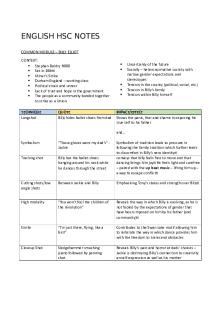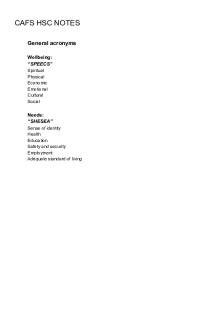Construction HSC Notes- Paul Trad PDF

| Title | Construction HSC Notes- Paul Trad |
|---|---|
| Author | Paul Trad |
| Course | VET Construction |
| Institution | Higher School Certificate (New South Wales) |
| Pages | 9 |
| File Size | 619.5 KB |
| File Type | |
| Total Downloads | 3 |
| Total Views | 133 |
Summary
Download Construction HSC Notes- Paul Trad PDF
Description
SST Safe work method statements (SWMS) - Describes how work is to be carried out. (Order of work) - It identifies the work activities which may have risks. - Describes control measures that can be used to nullify risks, and how they should be implemented. - Description of the equipment that will be used. - Standards of work, and the qualifications of the personnel undertaking the work. Safety Data Sheet (SDS) also can be known as the MSDS - Outlines the high risk activities, hazards that may arise, and measures to control the risk. - Document prepared by the supplier of a chemical product. The document states the hazardous nature. - Document shows precautions that must be followed to ensure that the material doesn’t impact anyone. - Includes ways to respond in emergency situations. Person Conducting Business Undertaking (PCBU) - A PCBU conducts business alone or with others. Safe operating procedure (SOP) - Description of how to use machines, and tools Job Safety Analysis - A procedure which describes the steps required to complete a certain task. - JSA should be completed before the SWMS - Analysis of the Job, identifying potential hazards, assessing associated risks and outlining control measures - Comparing to SWMS, JSA just lists the control measures, whereas SWMS describes them. Duty of care - Ensuring Safety for others, and yourself.
Identifying, assessing and controlling risks and hazards Hazard- Anything in the workplace that has the potential to harm, injure, damage, kill
or impact people or equipment. - Acute Hazard- Short term exposure to the hazard will cause an injury. (E.g Being burnt in an explosive fire) - Chronic Hazards- Long Term exposure to the hazard will cause injury, and sickness. (E.g SKin Cancer occurring from extended exposure to the sun.) Hierarchy of Hazard Controls 1st priority- Elimination 2nd Priority- Substitution 3rd priority- Engineering Controls (Isolation and guarding) 4th Priority- Administrative controls (Training and work scheduling) 5th Priority- PPE Measurements
Ladder against wall ratio is 1:4 Area or SA;
Volume
Trapezium
(a+b)/2 (H)
(a+b)/2(H) x L
Triangle
½ bh
Side of a Cylinder
2πrh
Total Cylinder
2πr^2+2πrh
πr^2h
Work Health and Safety - Work Health and Safety Act 2011 ❏ Provides a framework to protect the health, safety and welfare of all workers at work. It also protects the health and safety of all other
people who might be affected by the work. All workers are protected by this WHS act ❏ Regulating Authority is Safework NSW -
PPE -
Reasons for development of WHS Laws ❏ Self regulation not working ● Organisations regulating their own WHS programs wasn’t working. Evidence of this is 500 people were dying nationally due to work related accidents. ❏ National and overseas legal developments ● National, and international efforts to update WHS legislation. Made it modernised to the twentieth century. ❏ Many Workers not covered ● When WHS began approximately 1/3 of the workforce was covered. Today all workers are covered. ❏ Too much legislations ● There were 26 different acts, which over complicated the legislations. WHS brought upon stability. ❏ Cost of Compensation ● WHS legislation was introduced in conjunction with workers' compensation to provide for injured workers. Head (Safety Helmets, sun hats) Eyes/face (Goggles, face shields Hearing (Ear Muffs, ear plugs) Airways/lungs (Dust Masks) Hands (Gloves) Feet (safety boots that are steel cap) Body (High Vis, protective clothing from the sun)
Fire Extinguishers Safety Signs
Prohibition Sign (Red circle border) Something you must not do.
Mandatory Sign (Blue with a white symbol) Must do
Emergency information sign (Green, with white symbol) Shows where emergency equipment and exits are
Hazard Warning Signs (Yellow Triangle with black border, and symbol) Identifies any danger or risk to your health
Restriction Signs (Red circle, white background) Indicative of certain limitations
Danger Hazard Signs (White rectangular background, danger in red) Warning of a hazard or hazardous condition that can be life threatening
Fire Signs (Red square, white symbol) Location of fire alarms, and fire fighting facilities
Workplace Hazards - Lifting and handling materials - Noise - Vibration - Fire and explosions Examples of Safety Considerations - PPE - Manual Handling - Safety Gear Meetings - Can be both formal, and informal.
-
-
Formal meetings will have an agenda, which all workers have been made aware of. It will consist of minutes, and notes from the meeting to be recorded. Formal meetings are run by a chairperson who is usually people involved in the work site. Informal meetings can occur on short notice, and information about the work will be exchanged A toolbox meeting is an example of both a formal, and informal meeting. Purpose of meetings is to pass on information, resolve disputes, make workers aware of any amendments, and planning for future work.
Methods of ensuring a safe work environment - Barricades: Prevents entry, and signifies that a danger exists. - Signage: Informs others of hazards, dangers and required ppe. - Housekeeping: Ensuring work area is clean, and clear of any hazards. AN example could be sweeping any dust, or rubbish away from work areas. Plan Interpretations and specifications - Site or Block Plan ❏ Essential for determining the location of the building block. ❏ Information on a site plan: ❖ Distance from street to boundary ❖ Distance from side boundary to building ❖ Contour lines, and their heights. ❖ Trees ❖ Direction of North ❖ Lot number
-
Floor Plan ❏ Horizontal cut through section of the building as viewed from above. It is the most important of all the related views as it contains most of the information for construction. ❏ Items shown are: ❖ Dimensions of walls ❖ Door and Window positions ❖ Position of cupboards, stoves, laundry tubs, etc
-
Elevations ❏ Provide information relating to vertical measurements, and external finishes. ❏ They show: ❖ Height of finished floor level (FFL) ❖ Design of the building
-
Sections ❏ Elevations that cut through the building. ❏ The section is a cross section from the bottom of the footing, through the walls, ceiling, and roof structures. ❏ The information provided on sections are: ❖ Footing sizes ❖ Floor Construction ❖ Roof Pitch ❖ Section Sizes
-
Construction Details ❏ Sectional views drawn to a larger scale. ❏ Information it includes are ❖ Scale used for drawings ❖ Dimensions ❖ Title Block
Tools and
Equipment - Hammer ❏ Deliver an impact. E.g Driving nails into wood ❏ Types of Hammers: ➔ Claw Hammer ➔ Ball Pein Hammer - Chisel ❏ Used for carving, and cutting. ❏ Types of chisels: ➔ Mortise Chisel ➔ Bevel Edge Chisel Jobs in Construction - Carpenter ❖ Installation of timber wall frames. ❖ Installation of doors, and windows. Hazards
Post Trial Notes
-
Electrical Fire (Class C) contained by a Carbon Dioxide extinguisher Main services location located on site plan of a residential home 1500mm recommended floor level for safety sign. Always check deliver after arrival of order Good planning and organising allows for increased profits Factors affecting progress- Weather, Untidy workplace, delay in orders Residential Sector is in regards to domestic buildings such as: Granny Flats, extension to houses Commercial Sector refers to institutions such as Shopping Centres, hospitals, Schools 2.1 metres for height of extension lead above ground...
Similar Free PDFs

Ensayo TRAD
- 2 Pages

Paul Keating Speech Notes
- 1 Pages

Presentation Notes - Paul Bagdan
- 2 Pages

English HSC Notes
- 9 Pages

SDD HSC Full Notes
- 74 Pages

Shelter HSC Notes
- 13 Pages

CAFS HSC Notes
- 33 Pages

Ancient History HSC Notes
- 9 Pages

SDD HSC Notes, full
- 2 Pages

Shelter notes HSC
- 8 Pages

HSC Christianity Notes
- 8 Pages

Condenses HSC Notes
- 42 Pages

International Crime HSC notes
- 7 Pages

Sor hsc notes
- 25 Pages

Crime HSC Notes
- 33 Pages
Popular Institutions
- Tinajero National High School - Annex
- Politeknik Caltex Riau
- Yokohama City University
- SGT University
- University of Al-Qadisiyah
- Divine Word College of Vigan
- Techniek College Rotterdam
- Universidade de Santiago
- Universiti Teknologi MARA Cawangan Johor Kampus Pasir Gudang
- Poltekkes Kemenkes Yogyakarta
- Baguio City National High School
- Colegio san marcos
- preparatoria uno
- Centro de Bachillerato Tecnológico Industrial y de Servicios No. 107
- Dalian Maritime University
- Quang Trung Secondary School
- Colegio Tecnológico en Informática
- Corporación Regional de Educación Superior
- Grupo CEDVA
- Dar Al Uloom University
- Centro de Estudios Preuniversitarios de la Universidad Nacional de Ingeniería
- 上智大学
- Aakash International School, Nuna Majara
- San Felipe Neri Catholic School
- Kang Chiao International School - New Taipei City
- Misamis Occidental National High School
- Institución Educativa Escuela Normal Juan Ladrilleros
- Kolehiyo ng Pantukan
- Batanes State College
- Instituto Continental
- Sekolah Menengah Kejuruan Kesehatan Kaltara (Tarakan)
- Colegio de La Inmaculada Concepcion - Cebu
